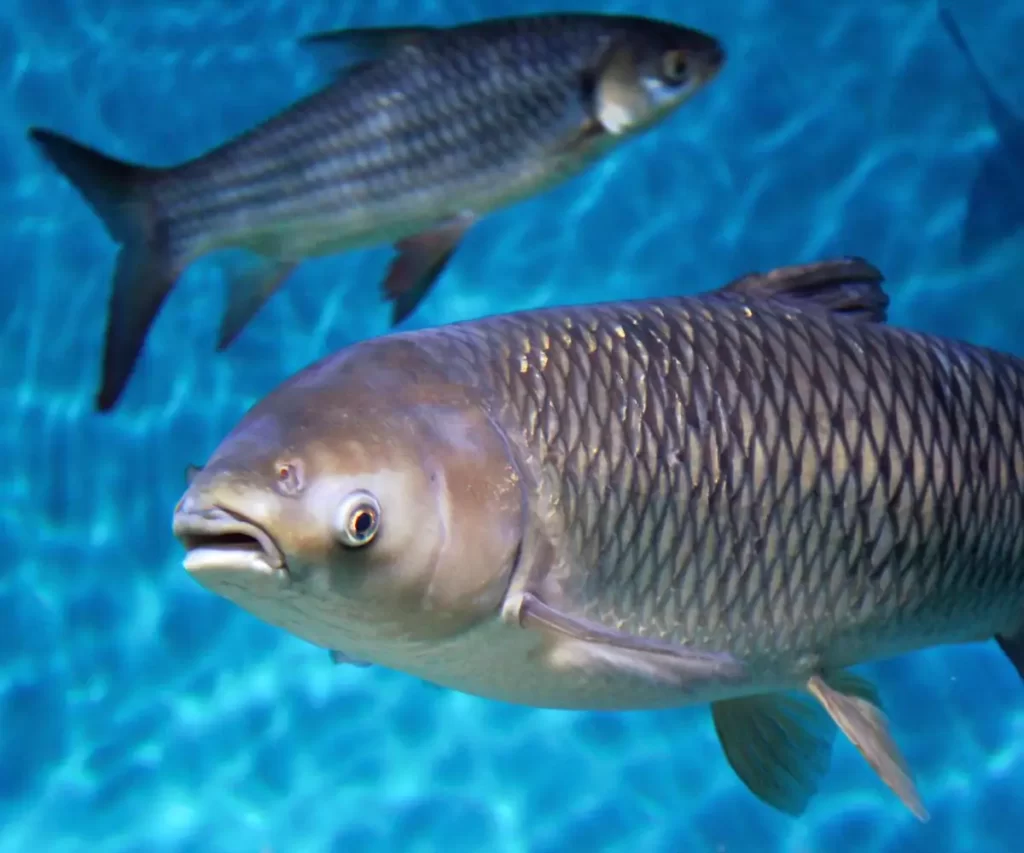
Bighead Carp Fish Species Guide
The Bighead Carp (Hypophthalmichthys nobilis) is a prominent freshwater fish species known for its distinctive appearance and ecological significance. Native to eastern Asia, particularly China, the Bighead Carp has gained attention globally due to its introduction into various water bodies around the world. This webpage delves into the key aspects of the Bighead Carp, including its physical characteristics, habitat preferences, behavior, reproduction, and the ecological impact it has on the ecosystems it inhabits.
Physical Characteristics
Appearance
The Bighead Carp is easily recognizable by its large head and mouth, which gives it its common name. It has a robust body with silvery scales, and its eyes are situated below the mouth. Adult Bighead Carps can reach impressive sizes, with some individuals exceeding 100 pounds in weight and lengths of up to four feet.
Coloration
While the general coloration of the Bighead Carp is silver, its back tends to be darker, ranging from olive to gray. The fins are typically a reddish color, and the tail fin is deeply forked.
Distinctive Features
One of the most distinctive features of the Bighead Carp is its lack of teeth in the upper jaw, unlike its close relative, the Silver Carp. Instead, it possesses specialized gill rakers designed for filter-feeding, a feeding behavior that sets it apart from many other fish species.
Habitat Preferences
Native Range
The Bighead Carp is native to the rivers and lakes of eastern Asia, specifically China. It is found in river systems such as the Yangtze and Yellow Rivers.
Global Distribution
Due to its introduction for aquaculture and unintentional releases, the Bighead Carp has established populations in various parts of the world. This includes North America, where it was introduced in the 1970s to control algae in aquaculture ponds.
Preferred Environments
Bighead Carps thrive in large rivers and lakes with slow to moderate currents. They are well-adapted to a variety of environmental conditions, including turbid water and fluctuating temperatures.
Behavior
Feeding Habits
Bighead Carps are filter feeders, utilizing their specialized gill rakers to extract plankton and other small particles from the water. This feeding behavior allows them to exploit abundant food resources, contributing to their rapid growth.
Movement Patterns
These fish are known for their migratory behavior, often moving upstream for spawning purposes. During their spawning migrations, Bighead Carps may cover significant distances, navigating through various water bodies.
Social Structure
Bighead Carps generally exhibit a schooling behavior, especially in their juvenile stages. These schools can vary in size, providing benefits such as enhanced protection from predators and increased foraging efficiency.
Reproduction
Spawning Behavior
Bighead Carps typically spawn in the spring or early summer when water temperatures rise. They prefer areas with strong currents for spawning. Female Bighead Carps release their eggs into the water, and males release sperm to fertilize them.
Egg Development
The fertilized eggs are buoyant and float in the water column. They drift downstream, and the larvae hatch within a few days. The larvae then undergo a pelagic stage before settling into more structured habitats as they mature.
Rapid Growth
Bighead Carps are known for their rapid growth rates, especially in the early stages of life. This, combined with their efficient filter-feeding, allows them to quickly reach sizes suitable for harvesting.
Ecological Impact
Competition with Native Species
One of the significant concerns associated with the introduction of Bighead Carp to non-native ecosystems is its competition with native fish species for food resources. As filter feeders, Bighead Carps consume vast amounts of plankton, potentially outcompeting native species and disrupting the balance of the aquatic food web.
Altered Ecosystem Dynamics
The presence of Bighead Carps can lead to changes in the structure and dynamics of aquatic ecosystems. Their feeding habits and rapid growth can result in altered nutrient cycling and phytoplankton dynamics, with potential cascading effects on other species within the ecosystem.
Impacts on Water Quality
In some cases, the proliferation of Bighead Carp populations has been associated with declines in water quality. The increased nutrient loading from their feces and the disruption of natural processes can contribute to water quality degradation.
Management and Control
Preventative Measures
To prevent the spread of Bighead Carp and mitigate their impact, various preventative measures are employed. These include regulations on the transport and release of live fish, as well as public awareness campaigns to discourage the release of Bighead Carp into non-native waters.
Research and Monitoring
Ongoing research is essential for understanding the behavior and ecology of Bighead Carp populations in different environments. Monitoring programs help track their distribution and abundance, providing valuable information for the development of effective management strategies.
Control Methods
Several control methods have been explored to manage Bighead Carp populations. These include physical barriers to prevent their movement, chemical controls, and the introduction of natural predators or competitors.
Conclusion to: Bighead Carp
In conclusion, the Bighead Carp is a fascinating fish species with a complex interplay of ecological interactions. While it has been valued for aquaculture in its native range, its introduction to non-native waters has raised concerns about its impact on ecosystems. Understanding the biology, behavior, and ecological consequences of the Bighead Carp is crucial for developing effective management strategies to mitigate its potential negative effects. Through research, monitoring, and thoughtful management, efforts can be made to strike a balance that protects both native biodiversity and the interests of human communities.